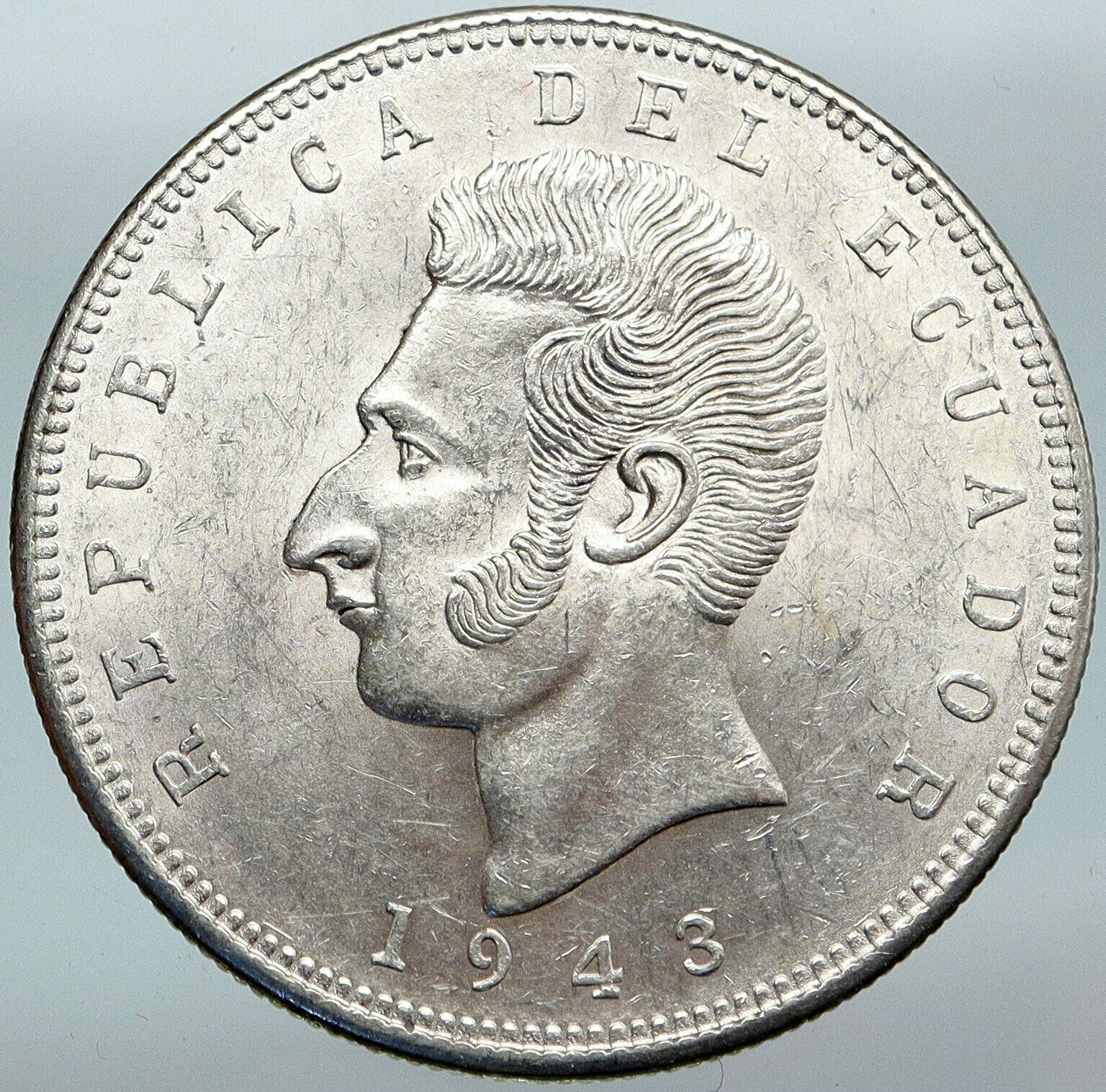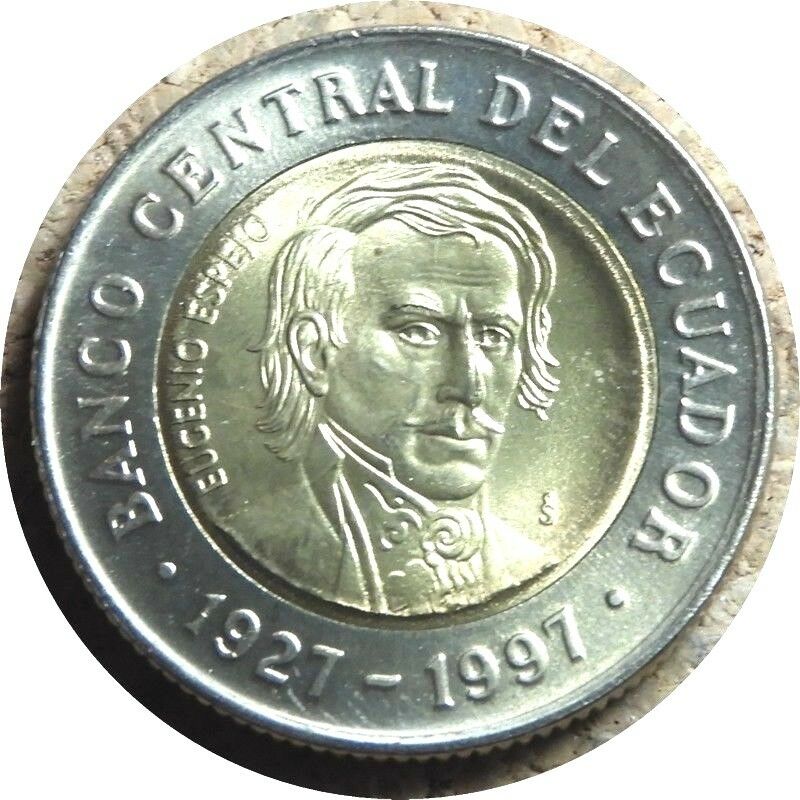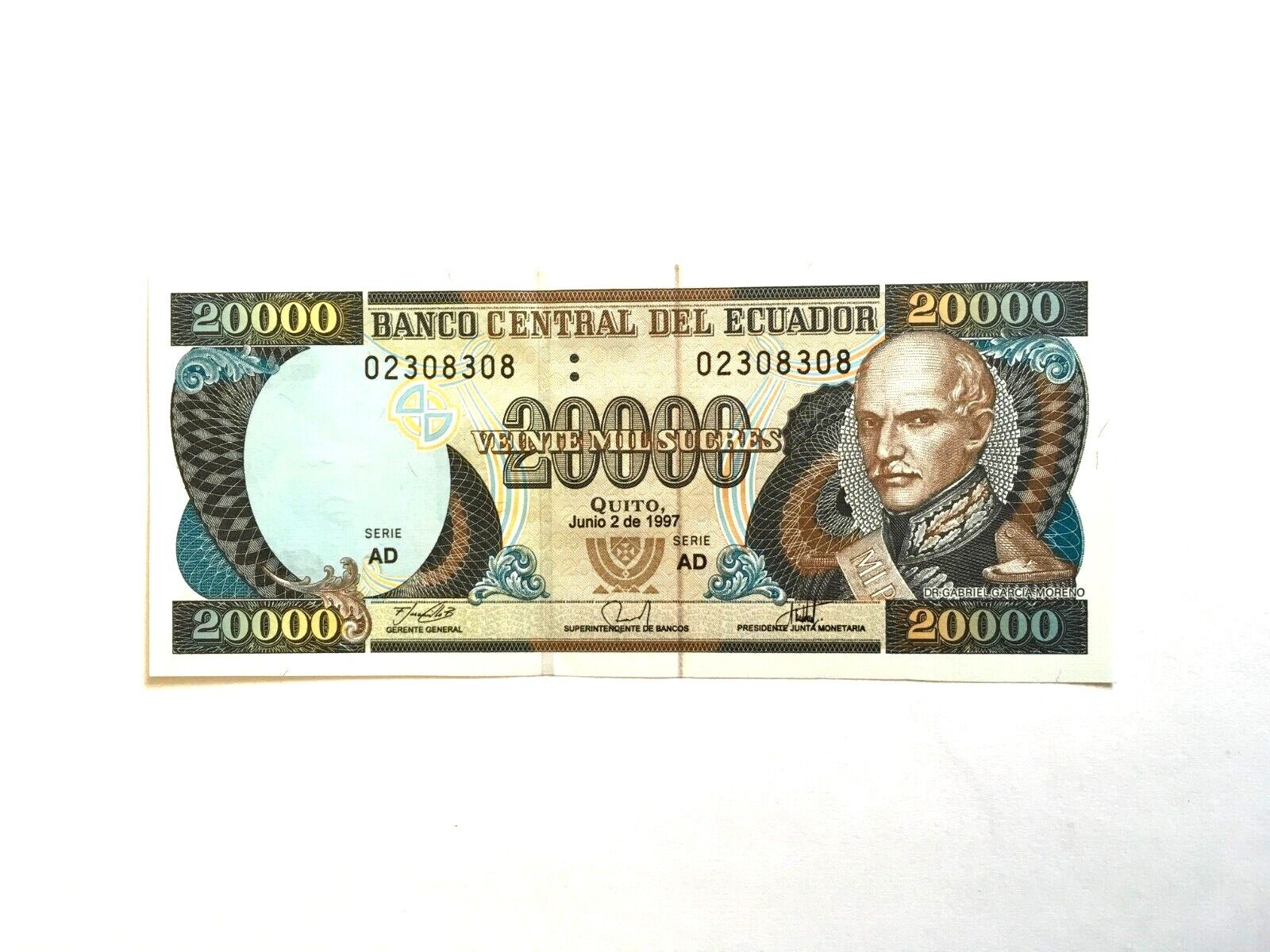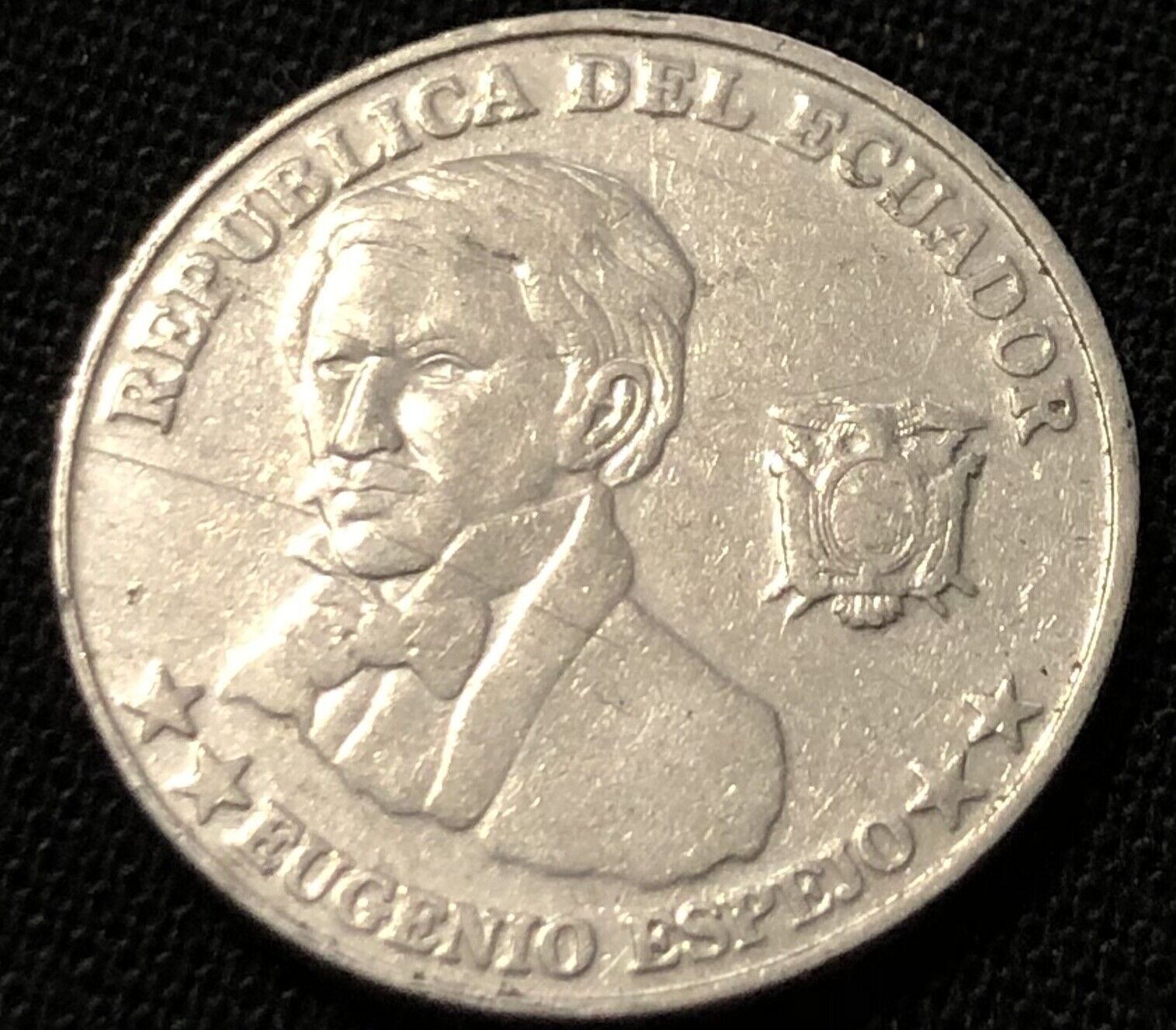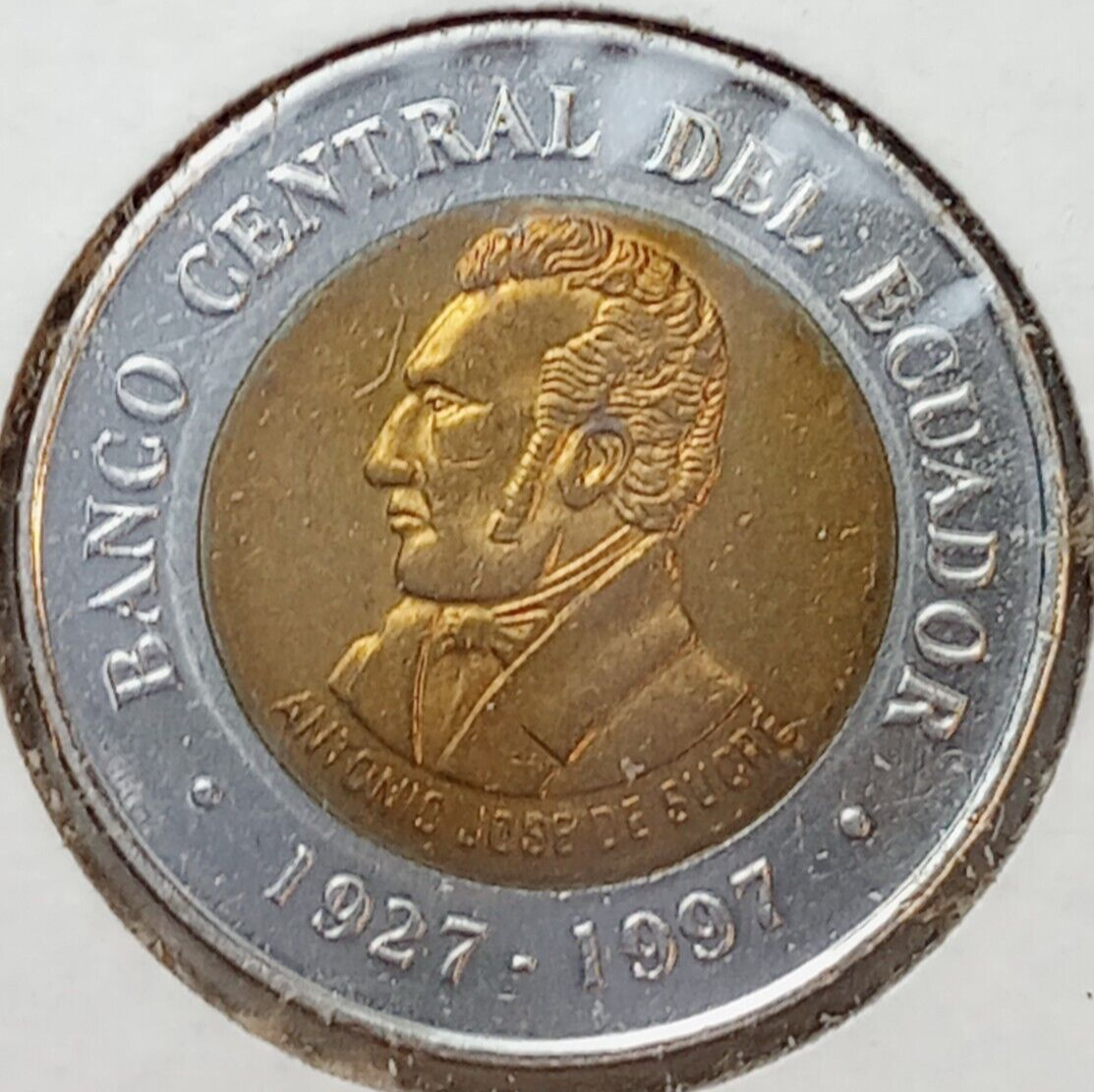-40%
1943 ECUADOR Antonio Jose de Sucre y Alcala Antique Silver 5 Sucres Coin i88157
$ 137.09
- Description
- Size Guide
Description
Item:i88157
Authentic Coin of:
Ecuador - Antonio Acala
1943
Silver 5 Sucres 37mm (
24.97
grams) 0.720 Silver (0.5787 oz. ASW)
Reference: KM# 79
REPUBLICA DEL ECUADOR, Name of the country, year of issue, head of Antonio José de Sucre facing left.
GRAM . 25 · CINCO SUCRES · LEY 0.720 MO MEXICO, Flag draped arms, eagle above, denomination above.
You are bidding on the exact item pictured, provided with a Certificate of Authenticity and Lifetime Guarantee of Authenticity.
Antonio José de Sucre y Alcalá
(Spanish: [anˈtonjo xoˈse ðe ˈsukɾe j alkaˈla]; 1795-1830), known as the "Gran Mariscal de Ayacucho" (English: "Grand Marshal of Ayacucho"), was a Venezuelan independence leader who served as the fourth President of Peru and the second President of Bolivia. Sucre was one of Simón Bolívar's closest friends, generals and statesmen. The city of Sucre, Bolivia's capital, is named for him, as is a state of Venezuela and a department of Colombia. Both the old and new airports of Ecuador's capital Quito are also named after him.
Family
The aristocratic Sucre family traces its roots back to origins in Flanders. It arrived in Venezuela through Charles de Sucre y Franco Perez, a Flemish nobleman, son of Charles Adrian de Sucre, Marquess of Peru and Buenaventura Carolina Isabel Garrido y Pardo, a Spanish noblewoman. Charles de Sucre y Pardo served as a soldier in Catalonia in 1698 and was later named Governor of Cartagena de Indias and Captain General of Cuba. On December 22, 1779, Charles de Sucre y Pardo arrived in Cumaná, Venezuela, having been named Governor of New Andalucia, which includes present-day Sucre State.
Military career
In 1814, Antonio José de Sucre joined the fight for South America independence from Spain. The Battle of Pichincha took place on May 24, 1822, on the slopes of the Pichincha volcano, near Quito in what is now Ecuador. The encounter, fought in the context of the Spanish American wars of independence, pitted a Patriot army under Sucre against a Royalist army commanded by Field Marshal Melchor Aymerich. The defeat of the Royalist forces brought about the liberation of Quito and secured the independence of the provinces belonging to the Real Audiencia de Quito, or Presidencia de Quito, the Spanish colonial administrative jurisdiction from which the Republic of Ecuador would eventually emerge.
As of late 1824, Royalists still had control of most of southern Peru as well as Real Felipe Fort in the port of Callao. On December 9, 1824, the Battle of Ayacucho took place at Pampa de La Quinua, near the town of Quinua, between Royalist and Patriot forces. Sucre, as Simón Bolívar's lieutenant, led the Patriot forces to victory over the Viceroy José de la Serna, who was wounded. After the battle, second commander-in-chief José de Canterac signed the final capitulation of the Royalist army on his behalf. As a result, he was promoted, at the request of the Peruvian Congress, to Marshal and as General in Chief by the Colombian legislature.
After the victory at Ayacucho, following precise orders from Bolívar, Sucre, nominated as Ayacucho's Grand Marshal, entered Upper Peru (known today as Bolivia) territory on February 25, 1825. Besides having orders of installing an immediately independent administration, his role was limited to giving an appearance of legality to the process that Upper Peruvians themselves had begun already.
Royalist general Pedro Antonio Olañeta stayed in Potosí, where he received by January the "Union" Infantry Battalion coming from Puno under the command of colonel José María Valdez. Olañeta then summoned a War Council, which agreed to continue the resistance in the name of Ferdinand VII. Next, Olañeta distributed his troops between Cotagaita fortress with the "Chichas" Battalion. in charge of colonel Medinacelli, while Valdez was sent to Chuquisaca with the "Union" Infantry Battalion and loyalist militias, and Olañeta himself marched toward Vitichi, with 60,000 pieces of gold from the Coin House in Potosí. But for the Spanish military personnel in Upper Peru, it was too little too late, as since 1821 all out guerilla warfare had raged in this part of the continent.
However, in Cochabamba the First Battalion of the Infantry Regiment "Ferdinand VII", led by colonel José Martínez, rebelled and side with the independence movement, only to be followed later by the Second Battalion, "Ferdinand VII" Infantry Regiment in Vallegrande, resulting in the forced resignation of Brigadier Francisco Aguilera on February 12. Royalist colonel José Manuel Mercado occupied Santa Cruz de la Sierra on February 14, as Chayanta stayed in the hands of lieutenant colonel Pedro Arraya, with the cavalry squadrons "Santa Victoria" (Holy Victory) and "Dragones Americanos" (American Dragoons), and in Chuquisaca the cavalry squadron "Dragones de la Frontera"(Frontier Dragoons) under colonel Francisco López claimed victory for the independence forces on February 22. At this point, the majority of royalist troops of Upper Peru refused to continue fighting against the powerful army of Sucre and switched allegiances. Colonel Medinacelli with 300 soldiers also revolted against Olañeta, and on April 2 of 1825 they faced each other in the Battle of Tumusla, which ended with the death of Olañeta. A few days later, on April 7, general José Mario Valdez surrendered in Chequelte to general Urdininea, putting an end to the war in Upper Peru and signalling victory to the local independence movement which had been active since 1811.
Role in the foundation of Bolivia
After the Constituent Assembly in Chuquisaca was reconvened by Marshal Sucre, on July 8 of 1825, and then later concluded, it was determined the complete independence of Upper Peru under the republican form. Finally, the Assembly president José Mariano Serrano, together with a commission, wrote down the "Independence Act of the Upper Peruvian Departments" which carries the date of August 6, 1825, in honor of the Battle of Junín won by Bolivar. Independence was declared by 7 representatives from Charcas, 14 from Potosí, 12 from La Paz, 13 from Cochabamba and 2 from Santa Cruz. The act of Independence, wrote by the president of the Congress, Serrano, states in its expositive part:
"The world knows that the land of Upper Peru has been, in the American continent, the altar where the free people shed the first blood, and the land where the last of the tyrants' tombs finally lays. Today, the Upper Peruvian departments protest in the face of the whole Earth its irrevocable resolution to be governed by themselves."
Through a decree it was determined that the new state in Upper Peru would carry the name of República Bolívar, in honor of the liberator, who was designated as "Father of the Republic and Supreme Chief of State". Bolívar thanked them for these honors, but declined the presidency of the Republic, a duty he gave instead to the victor of Ayacucho, Grand Marshal Sucre, who would later be sworn in the same day as the first President of Bolivia. After some time, the subject of the name of the Young nation arose again, and a Potosian deputy named Manuel Martín Cruz offered a solution, suggesting that in the same manner which from Romulus comes Rome, from Bolívar ought to come the new nation of Bolivia.
"If from Romulus, Rome; from Bolívar, it is Bolivia".
By the time Bolívar got the news of the decision, he felt flattered by the young nation, but until then he hadn't accepted willingly Upper Peru's because he was worried about its future, due to Bolivia's location in the center of South America; this, according to Bolivar, would create a nation that would face many future wars, which curiously did happen. Bolivar wished that Bolivia would become part of another nation, preferably Peru (given the fact that it had been part of Viceroyalty del Perú for centuries), or Argentina (since during the last decades of colonial domain it had been part of Viceroyalty del Río de la Plata), but what deeply convinced him otherwise was the attitude of the people. On August 18, upon his arrival to La Paz, there was a manifestation of popular rejoicing. The same scene repeated when the Liberator arrived to Oruro, then to Potosí and finally to Chuquisaca. Such a fervent demonstration by the people touched Bolívar, who called the new nation his "Predilect Daughter", and was called by the peoples of the new republic their "Favorite Son".
After the foundation of Bolivia, he became also the commander in chief of the Armed Forces of Bolivia, which he created the following day on the basis of the guerrilla forces and active Patriot armies stationed at the time of the declaration. He gave the young republic its first Constitution in 1828.
Battle of Tarqui
In the Battle of Tarqui, fought on February 27, 1829, heavily outnumbered two to one, Sucre defeated a Peruvian invasion force led by third President and General of Peru José de La Mar, whose intentions had been to annex Guayaquil and the rest of Ecuador to Peru.
Post-independence
When a strong movement arose against Bolívar, his followers, and the Bolivian constitution in 1828, Sucre resigned.
Assassination
Sucre was killed on June 4, 1830. General Juan José Flores wanted to separate the southern departments (Quito, Guayaquil, and Azuay), called the District of Ecuador, from the Gran Colombia so as to form an independent country and become its first President. General Flores foresaw that if Antonio José de Sucre arrived in Quito from Bogota, he could thwart his plans, since Sucre was very popular due to his reputation as hero and leader in the Battles of Pichincha, Tarqui and Ayacucho. General Juan José Flores put himself in contact with the anti-Bolívar and anti-Sucre leader Brigadier-General and the Commanding General of Cauca, José María Obando, who was not present at Sucre's death but who delegated this criminal act to the Venezuelan Colonel Apolinar Morillo. Commander Juan Gregorio Sarria (who later confessed he had been paid by Obando), José Erazo (a highway bandit and guerrilla fighter), and three peons as accomplices. The plan was to ambush José Antonio de Sucre on the morning of June 4, 1830, in the cold and bleak forested district of Berruecos, along a narrow path that was perennially covered with fog.
The five assassins were hiding behind trees along the part of the trail known as La Jacoba waiting for Sucre's party, which would be passing the area single file. Sucre's retinue comprised seven persons: two muleteers with the baggage, two sergeants, one being the Marshal's orderly, a representative to the Congress from Cuenca, and his servant, and finally Sucre himself. When Sucre approached La Jacoba, he was struck by three bullets, two inflicting superficial wounds to his head and one piercing his heart. He fell from his horse, which had been shot in the neck, and died almost instantly. His body remained there for twenty-four hours, as his companions, fearful of a similar fate, had fled in panic.
Later, Juan Gregorio Sarria and Colonel Apolinar Morillo confessed that it was Obando who had convinced them to assassinate Sucre. Commander Juan Gregorio Sarria also confessed that Obando had paid him to kill Sucre, since there were anti-Bolivar politicians and officers in Bogota that wanted to see both Bolívar and Sucre eliminated. The ringleader of the anti-Bolívar faction in Bogota was Santander, who was Obando's friend and who had failed in his attempt to assassinate Bolivar[citation needed]. The three peons who were part of the Sucre assassination party were poisoned by Apolinar Morillo to prevent them from testifying about Sucre's murder. In the end, Colonel Apolinar Morillo was convicted and shot in the main square of Bogota for the murder of Sucre on November 30, 1842, and José Erazo died in prison that same year. José Maria Obando was granted immunity due to the fact that he was too powerful in the Cauca Department. Francisco de Paula Santander, although indirectly involved with Sucre's death, was directly involved with Bolívar's attempted assassination and was exiled.
The following day Sucre's orderly, a sergeant named Lorenzo Caicedo, with some help from others, buried the body and marked the makeshift grave with a cross formed of branches. When the widow received news of the assassination, she promptly brought Sucre's remains from Berruecos to Quito, where they were interred in secret in the oratory of the chapel of "El Dean" on one of her haciendas. Subsequently, she had the remains transferred, also in secret, to the Carmen Bajo Convent in Quito, where they were placed facing the main altar of the church. Seventy years later, in April 1900, Sucre's remains were discovered and, their authenticity scrupulously verified, transferred to the Quito Cathedral on June 4, 1900, in a sumptuous parade led by the Executive and his Ministers, the high dignitaries of the Church, and the diplomatic corps. At the time, the government ordered the building of a crypt, but it was not inaugurated until thirty-two years later, on August 4, 1932. This mausoleum consisted of a nine-ton monolith of granite from the quarries of the Pichincha volcano. Its cover, on which a cross is carved in high relief, was so heavy that thirty persons were required to move it into place.
According to the December 19, 1830 Gaceta de Colombia, Issue No. 495, a power-hungry, ambitious General Obando paid an assassin to kill Sucre by falsely informing the assassin that Sucre was a traitor and had to be stopped because Sucre's intentions were to go to Quito and separate the Department of Cauca and the three southern departments of Colombia and unite them with Peru. In reality, Sucre, a protégé of Bolívar, was going to Quito to stop the separation of the District of Ecuador from the Gran Colombia and to retire as soon as possible in Quito to live a quiet life with his wife. Some have argued that Sucre was ordered assassinated by General Obando so as to leave no clear successor to Bolívar in the Gran Colombia. Before his death, Bolívar believed Sucre to be the only man who could have reunited the Gran Colombia; however, Bolívar's generals and the majority of the politicians running the separate departments of the Gran Colombia had other selfish and ambitious plans. Sucre represented, according to historian Tomás Polanco Alcántara, "the indispensable complement to Simón Bolívar". Upon hearing the news of Sucre's death, Bolívar said, "Se ha derramado, Dios excelso, la sangre del inocente Abel..." ("The blood of the innocent Abel has been spilled, oh God almighty..."). Bolívar later wrote (Gaceta de Colombia, July 4, 1830):
" If he had breathed his spirit upon the theater of victory, with his last breath he would have given thanks to heaven for having given him a glorious death; but cowardly murdered in a dark mountain, he leaves his fatherland the duty of prosecuting this crime and of adopting measures that will curb new scandals and the repetition of scenes as lamentable and painful as this.
"
Sucre is buried in the Cathedral of Quito, Ecuador, as he had said, "I want my bones to be forever in Quito", where his wife, Mariana de Carcelén y Larrea, Marquise of Solanda, was from.
Ecuador
(/ˈɛkwədɔːr/
EK-wə-dor
, Spanish: [ekwaˈðoɾ]) (Quechua:
Ikwayur
), officially the
Republic of Ecuador
(Spanish:
República del Ecuador
, which literally translates as "Republic of the Equator"; Quechua:
Ikwadur Ripuwlika
), is a country in northwestern South America, bordered by Colombia on the north, Peru on the east and south, and the Pacific Ocean to the west. Ecuador also includes the Galápagos Islands in the Pacific, about 1,000 kilometres (620 mi) west of the mainland. The capital city is Quito, while the largest city is Guayaquil.
What is now Ecuador was home to a variety of Amerindian groups that were gradually incorporated into the Inca Empire during the 15th century. The territory was colonized by Spain during the 16th century, achieving independence in 1820 as part of Gran Colombia, from which it emerged as its own sovereign state in 1830. The legacy of both empires is reflected in Ecuador's ethnically diverse population, with most of its 16.4 million people being mestizos, followed by large minorities of European, Amerindian, and African descendants. Spanish is the official language and is spoken by a majority of the population, though 13 Amerindian languages are also recognized, including Quichua and Shuar.
The sovereign state of Ecuador is a middle-income representative democratic republic with a developing economy that is highly dependent on commodities, namely petroleum and agricultural products. It is governed as a democratic presidential republic. One of 17 megadiverse countries in the world, Ecuador hosts many endemic plants and animals, such as those of the Galápagos Islands. In recognition of its unique ecological heritage, the new constitution of 2008 is the first in the world to recognize legally enforceable Rights of Nature, or ecosystem rights.
Frequently Asked Questions
Mr. Ilya Zlobin
, world-renowned expert numismatist, enthusiast, author and dealer in authentic ancient Greek, ancient Roman, ancient Byzantine, world coins & more.
Who am I dealing with?
You are dealing with Ilya Zlobin, ancient coin expert, enthusiast, author and dealer with an online store having a selection of over 15,000 items with great positive feedback from verified buyers and over 10 years experience dealing with over 57,000 ancient and world coins and artifacts. Ilya Zlobin is an independent individual who has a passion for coin collecting, research and understanding the importance of the historical context and significance all coins and objects represent. Most others are only concerned with selling you, Ilya Zlobin is most interested in educating you on the subject, and providing the largest selection, most professional presentation and service for the best long-term value for collectors worldwide creating returning patrons sharing in the passion of ancient and world coin collecting for a lifetime.
How long until my order is shipped?
Orders are shipped by the next business day (after receipt of payment) most of the time.
How will I know when the order was shipped?
After your order has shipped, you will be left positive feedback, and that date could be used as a basis of estimating an arrival date. Any tracking number would be found under your 'Purchase history' tab.
USPS First Class mail takes about 3-5 business days to arrive in the U.S. International shipping times cannot be estimated as they vary from country to country.
Standard international mail to many countries
does not
include a tracking number, and can also be slow sometimes.
For a tracking number and signature confirmation, you may want to do Express Mail International Shipping, which costs more, however, is the fastest and most secure. Additionally you may be able to receive your order in as little as 3-5 business days using this method. For Express Mail International, it may be possible to place up to 10-15 items in one package (for the one shipping cost) as it is flat rate envelope, which may be the most cost-effective, secure and fastest way to receive items internationally. Send me a message about this and I can update your invoice should you want this method.
Getting your order to you, quickly and securely is a top priority and is taken seriously here.
Great care is taken in packaging and mailing every item securely and quickly.
Please be aware, I cannot take responsibility for any postal service delivery delays, especially for international packages as it may happen in rare instances.
What is a certificate of authenticity and what guarantees do you give that the item is authentic?
Each of the items sold here, is provided with a Certificate of Authenticity, and a Lifetime Guarantee of Authenticity, issued by a world-renowned numismatic and antique expert that has identified over 57,000 ancient coins and has provided them with the same guarantee. You will be very happy with what you get with the COA; a professional presentation of the coin, with all of the relevant information and a picture of the coin you saw in the listing. Additionally, the coin is inside it's own protective coin flip (holder), with a 2x2 inch description of the coin matching the individual number on the COA.
On the free-market such a presentation alone, can be considered a - value all in itself, and it comes standard with your purchases from me,
FREE.
With every purchase, you are leveraging my many years of experience to get a more complete context and understanding of the piece of history you are getting. Whether your goal is to collect or give the item as a gift, coins presented like this could be more prized and valued higher than items that were not given such care and attention to.
Buy a coin today and own a piece of history, guaranteed.
Is there a money back guarantee?
I offer a 30 day unconditional money back guarantee. I stand behind my coins and would be willing to exchange your order for either store credit towards other coins, or refund, minus shipping expenses, within 30 days from the receipt of your order. My goal is to have the returning customers for a lifetime, and I am so sure in my coins, their authenticity, numismatic value and beauty, I can offer such a guarantee.
When should I leave feedback?
Once you receive your order, please leave a positive feedback. Please don't leave any negative feedbacks, as it happens sometimes that people rush to leave feedback before letting sufficient time for their order to arrive. Also, if you sent an email, make sure to check for my reply in your messages before claiming that you didn't receive a response. The matter of fact is that any issues can be resolved, as reputation is most important to me. My goal is to provide superior products and quality of service.
How and where do I learn more about collecting ancient coins?
Visit the "
Guide on How to Use My Store
" for on an overview about using my store, with additional information and links to all other parts of my store which may include educational information on topics you are looking for.
